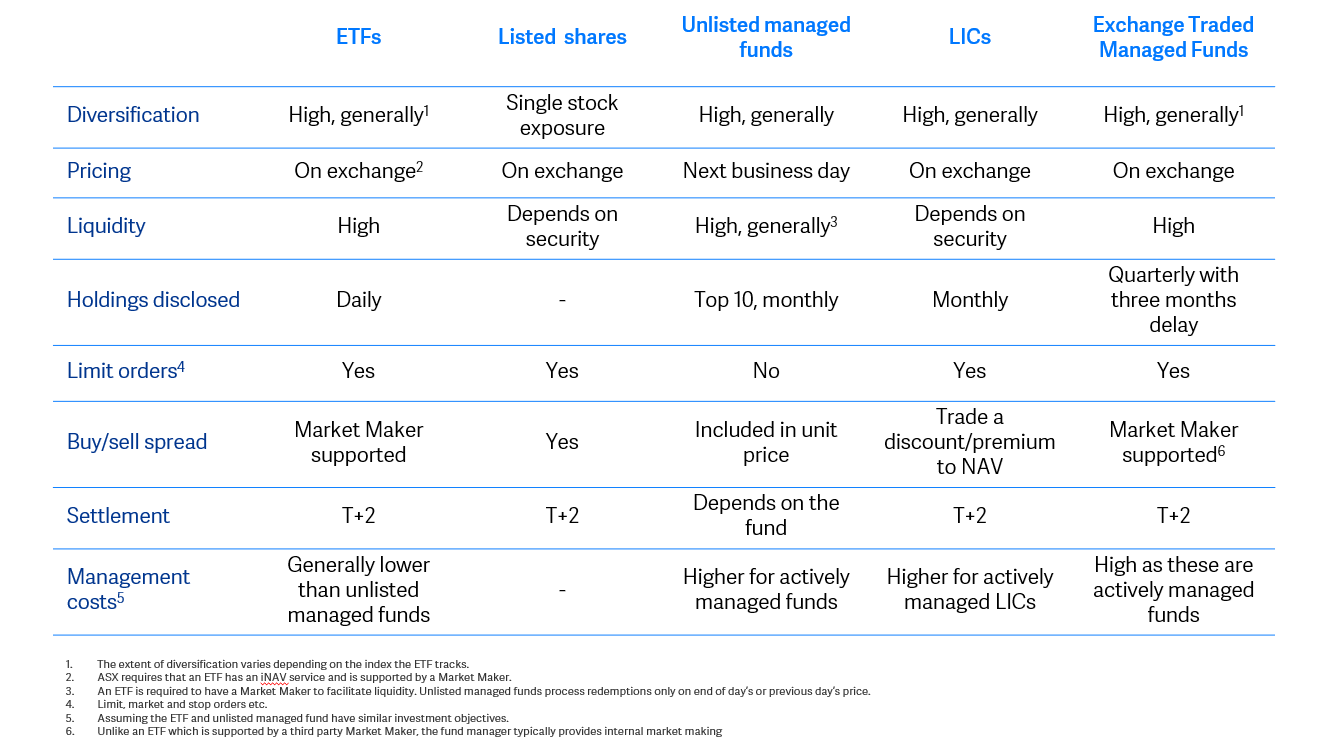Like a stock, Exchange Traded Funds (ETFs) are traded on the ASX and like a fund, they’re diversified and professionally managed.
Damon Gosen, Vice President of Business Development with VanEck, recently discussed ETFs in a Netwealth webinar: Understanding, exploring and selecting Exchange Traded Funds. Gosen takes us through the features and benefits of ETFs, trading tips and how to choose ETFs that are right for your portfolio.
A brief history of ETFs
Gosen says while index investing through ETFs was initially seen as a niche product, it found increased popularity as investors became more fee-conscious.
When the GFC hit, ETFs continued to receive inflows as investors were attracted to instant verification and transparency, and have continued to grow as a low-cost option for instant diversification.
Trading ETFs v managed funds
Gosen emphasises the flexibility of ETF trades compared to managed funds.
“If you want to buy or sell out of your managed fund, it can take a while for the actual buy or the sell to take place, and up to seven days to settle,” he says.
ETFs invest in the secondary market throughout the ASX trading day, using a market maker to offer liquidity by keeping the price in line with its net asset value.
“Because the ETF trades close to its net asset value, you’re getting a fair price when you're buying or selling.”
Liquidity in your investment portfolio
Gosen says liquidity is one of the attractions of ETFs for many direct investors. ETFs are open-ended so money can come into the fund and create more units.
“You can trade them as you need to. When money is leaving the ETF there's a redemption process which provides benefits such as liquid asset access and tax efficiency,” says Gosen.
“But remember that ETFs are only as liquid as the underlying assets.”
The bid/ask spread -the difference between the highest price a buyer will pay for an ETF unit and the lowest price the seller will accept - is a good indication of liquidity.
“The spread width is an indication of supply and demand,” Gosen explains.
“The greater the liquidity of the underlying investments, the tighter the spread.”
Hear more on ETFs
ETF trading tips
Gosen says buying an ETF is just like trading a share. You put in your trade size either through:
- A market order (buy or sell at market price)—this guarantees you buy or sell your units; or
- A limit order—you set the price you’re willing to buy or sell at (recommended by Gosen).
“With one trade you can get access to an entire thematic,” Gosen says.
“ETFs help investors bring down their overall fee load, and fees are one part of your investment return you can control.”
More key ETF features
According to Gosen, other key features attracting investors and driving global growth include:
- Cost-effectiveness—low management costs
- Tax-efficiency—the structure of ETFs can mean capital gains tax advantages
- Exchange trading—live pricing throughout the day so you get a fair price at the time you actually buy or sell
- Adaptability—they offer broad-based exposure to different asset classes and individual sectors or regions. For example, you can buy a technology ETF or a Chinese ETF.
“Transparency is also key,” says Gosen. “We have 16 funds on the ASX - you can look at our website and see the full holdings every day.”
Source: Vaneck
Choosing the right ETF
Gosen says researching the ETF issuer is a crucial first step.
“There's a lot to look at in terms of who the ETF issuer actually is and whether they're trusted,” he says.
“How do they operate? How big is their business? What's their risk management process? How easy to navigate is their website?”
Gosen also recommends doing your homework on:
- Portfolio exposure - What type of index is it and what securities are in it?
- Liquidity - Can you trade when you need to and how liquid are the underlying assets?
- Costs - What are the management costs and brokerage fees?
The future of ETFs
Gosen says ETFs have a bright future.
“Last year, more money in the US went into ETFs than managed funds,” says Gosen.
“Both globally and locally ETFs are growing very strongly. A broad range of investors are using them, and they're using them as building blocks for portfolio construction,” he says.
Want to know more about ETFs?
Listen to the complete Understanding, exploring and selecting Exchange Traded Funds webinar, learn about Smart Beta ETFs or contact Netwealth to find out more.
Compare managed funds and models
Get the latest research data and commentary to search and compare managed funds and managed account models. See performance data, costs and use powerful filtering tools to identify funds by manager and asset classes.
The information in this article is general in nature. Any financial advice it contains is general advice only and has been prepared without taking into account the objectives, financial situation or needs of any particular person. The article content is not intended to be a substitute for professional advice, so before you act on it you should determine its appropriateness having regard to your particular objectives, financial situation and needs, and seek any professional advice you require. Any reference to a particular investment is not a recommendation to buy, sell or hold the investment. The relevant disclosure document should be obtained from Netwealth and considered before deciding whether to acquire, dispose of, or to continue to hold, an investment in any Netwealth product.

